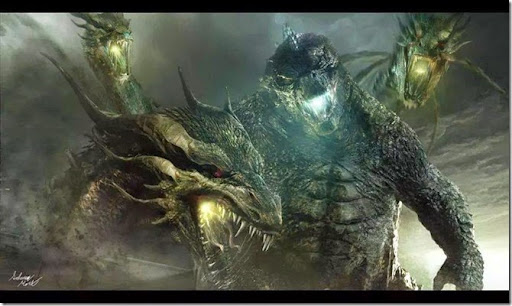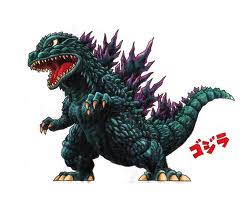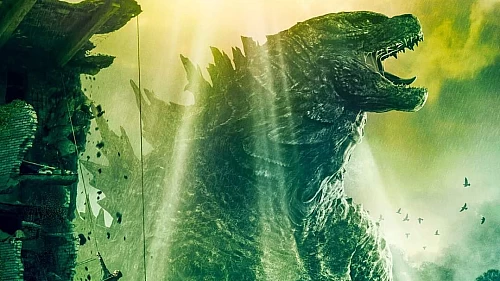The (Potential) Science of Legendary's Godzilla
Godzilla 2014 Forum Topic

B. M. H.
MemberMothra LarvaeSeptember 23, 20147379 Views6 Replies
Truth be told, I enjoyed Godzilla a lot. Probably due to my lifelong conditioning to love anything reptilian and large. Additionally, I enjoyed it more watching it a second time on Blu-ray the other day, because I had a better idea what to expect, and I had bonus features to help fill out some of the missing background meat from the movie.
But still, they expect us to suspend disbelief about ginormous freaking monsters, but don’t give us anything plausible to work with? What’s the biology of an immense animal that ‘feeds’ off radiation? How would any organism survive the proposed MILLIONS of years?
I've compiled some theoretical scientific explinations for these questions:
Problem 1: Creatures that Feed on Radioactivity:
Alright, lets do this. I’ve given this some thought, and despite the immense size of the subjects, I believe the secret to solving this plot-gap lies in some of the smallest organisms on the planet, which also happen to be some of the most ancient (See? I’m already thinking ahead here).
What very few humans seems to realize is just how much of our world and history has been shaped by microbes. From the gold that fueled the invasion of the Americas (Gold is bacterial poop. Yep, I went there), to the plagues that have changed history and the human genome, to our own human digestive tracts which we abuse with McDonalds and Starbucks on a daily basis (guilty as charged).

Likewise, the only organisms on the planet which can not only survive high degrees of radiation, but also consume it, are microscopic bacteria and fungi.
In the not-so-distant past, humans believed, with absolute conviction, that all life was utterly dependent (to some extent or other) on sunlight. We even went so far as to assume that the deep-sea ecosystems, which have never seen the light of day, were still dependent on oxygen (produced by photosynthesizing plants) dissolved in the water. But in the 1960s, scientists discovered super-survivor ‘extremophile’ microbes in the deep-seas (like where Godzilla had supposedly been hibernating), and even inside solid rock (for burrowing creatures like the M.U.T.O.),

that were capable of surviving, or even flourishing, in niche environments we’d thought nothing could survive in; like near-boiling water, high-acidity environments, and solid rock at high pressures and temperatures (Which is part of how ore veins form within cooling volcanic rock).
According to this National Science Foundation (NSF) article,
“The microbes were forced to survive on the leftovers that result when radioactivity from uranium, thorium and potassium in the native rock breaks down molecules of water, prompting a sequence of chemical reactions that produce hydrogen peroxide, break down pyrite, and form sulfates.”
The microbes then store the energy released from this process. (Click here to read the details of how radiation is converted into food)
The Daily Galaxy identified one of these bacterial species in their (far more humorous) article, “Super Cells”.
“Geobacter sulfurreducens has already been used at the Rifle Mills site to clear up a large amount of what the nuclear industry calls "oops!", and what us non-radioactive humans call "a goddamn nuclear contamination of groundwater and the Colorado river".”
The Daily Galaxy’s article also goes on to describe a similar bacterial strain which generates electricity, which could prove useful in explaining Godzilla’s spinal bioluminescence, or perhaps the biology of future Kaiju that utilize electricity (I’m looking at you King Ghidorah).
Problem 2: ‘Ancient’ Creatures Of Unusual Size
The lifespan of these bacteria could also be extrapolated to explain the utterly ridiculous Kaiju lifespan. The radiation-eating sub-surface microbes reproduce so slowly, they are estimated to only do so once in every 1-300 years. Tullis Onstott of Princeton University, Lisa Pratt of Indiana University and colleagues suspect that, due to their isolation and slow reproduction, these bacteria are minimally different than they were millions of years ago when they became isolated from the surface.
“These rock-dwellers may be some of above-ground life’s oldest relatives.” (NSF)
Well, gee, that serves our purposes rather nicely!
Okay, so we have a plausible way for Kaiju like Godzilla and the M.U.T.O.s to convert radiation into food, and a potential alibi for their redonkulous longevity.
Problem 3: Where did they come from?
Convergent Evolution. Duh, everybody knows about that…
Wikipedia (with its infallible accuracy) defines convergent evolution thus:
“Convergent evolution describes the independent evolution of similar features in species of different lineages. Convergent evolution creates analogous structures that have similar form or function, but that were not present in the last common ancestor of those groups.[1] The recurrent evolution of flight is a classic example of convergent evolution. Flying insects, birds, and bats have all evolved the capacity of flight independently. They have "converged" on this useful trait” (Wikipedia: Convergent Evolution)
 Translated for the rest of us, it roughly states that similar forms can evolve from different places. Like how placental mammals and marsupials both evolved similar forms of wolves, bears, and lions. And how many different creatures evolved similar winged forms to fly; like Cretaceous pterosaurs, feathered birds, and mammalian bats.
Translated for the rest of us, it roughly states that similar forms can evolve from different places. Like how placental mammals and marsupials both evolved similar forms of wolves, bears, and lions. And how many different creatures evolved similar winged forms to fly; like Cretaceous pterosaurs, feathered birds, and mammalian bats.
This can be used to explain how animals of a similar order can bear such radically different traits, like Godzilla possessing spinal plates, gills, and bioluminescence on a reptilian physiology, while the M.U.T.O.s possess a more insectile exoskeleton.
Kaiju would be animals so dramatically alien from anything we know, with such unique and odd evolutionary modifications, from such a long timeline, that I can see no other way to explain them. Godzilla is not a dinosaur, and the M.U.T.O.s are not insects; they are instead a different Kingdom or Phylum altogether that merely resembles more familiar forms. Likely from a period so far ahead of the pre-Cambrian that almost all potential fossil evidence of them could have conceivably been recycled by the earth’s geological and tectonic processes so that their existence would have been impossible to determine outside the mythology of human cultures.
Indeed, if we’re going this far to explain the feasibility of Kaiju, then we might as well just assume that they evolved from the earliest forms of radiation-eating bacteria, and maintain many of the survival hallmarks that would imply.
Sincerely,
Sources:
- Armstrong, W. P. "Convergent vs. Parallel Evolution." Convergent vs. Parallel Evolution. N.p., n.d. Web. 23 Sept. 2014. http://waynesword.palomar.edu/convevol.htm.
- "Bacteria and Digestion." NEWTON. DOE Office of Science, n.d. Web. 23 Sept. 2014. http://www.newton.dep.anl.gov/askasci/mole00/mole00129.htm.
- "Convergent Evolution." Wikipedia. Wikimedia Foundation, 29 Aug. 2014. Web. 23 Sept. 2014. http://en.wikipedia.org/wiki/Convergent_evolution.
- "Godzilla." Legendary Films. N.p., n.d. Web. 23 Sept. 2014. http://www.legendary.com/films/godzilla.
- "Goldbugs." The Economist. The Economist Newspaper, 21 July 2001. Web. 23 Sept. 2014. http://www.economist.com/node/699565.
- Kolawole, Emi. "Bacteria That Poop Gold?" Washington Post. The Washington Post, 10 Oct. 2012. Web. 23 Sept. 2014. http://www.washingtonpost.com/blogs/innovations/post/a-bacteria-that-poops-gold-yep-that-exists-and-its-in-an-art-exhibit-video/2012/10/04/1617f178-0e5d-11e2-bd1a-b868e65d57eb_blog.html.
- McKinney, Luke. ""Super Cells" That Can Eat Radiation, Generate Electricity and Cure Cancer." The Daily Galaxy. N.p., n.d. Web. 23 Sept. 2014. http://www.dailygalaxy.com/my_weblog/2010/04/super-cells-that-can-eat-radiation-generate-electricity-and-cure-cancer.html.
- Pennisi, Elizabeth. "Black Death Left a Mark on Human Genome." AAAS. The American Association for the Advancement of Science, 3 Feb. 2014. Web. 23 Sept. 2014. http://news.sciencemag.org/biology/2014/02/black-death-left-mark-human-genome.
- "Special Report: X-Treme Microbes." National Science Foundation. N.p., n.d. Web. 23 Sept. 2014. http://www.nsf.gov/news/special_reports/microbes/textonly/eaters.jsp.









